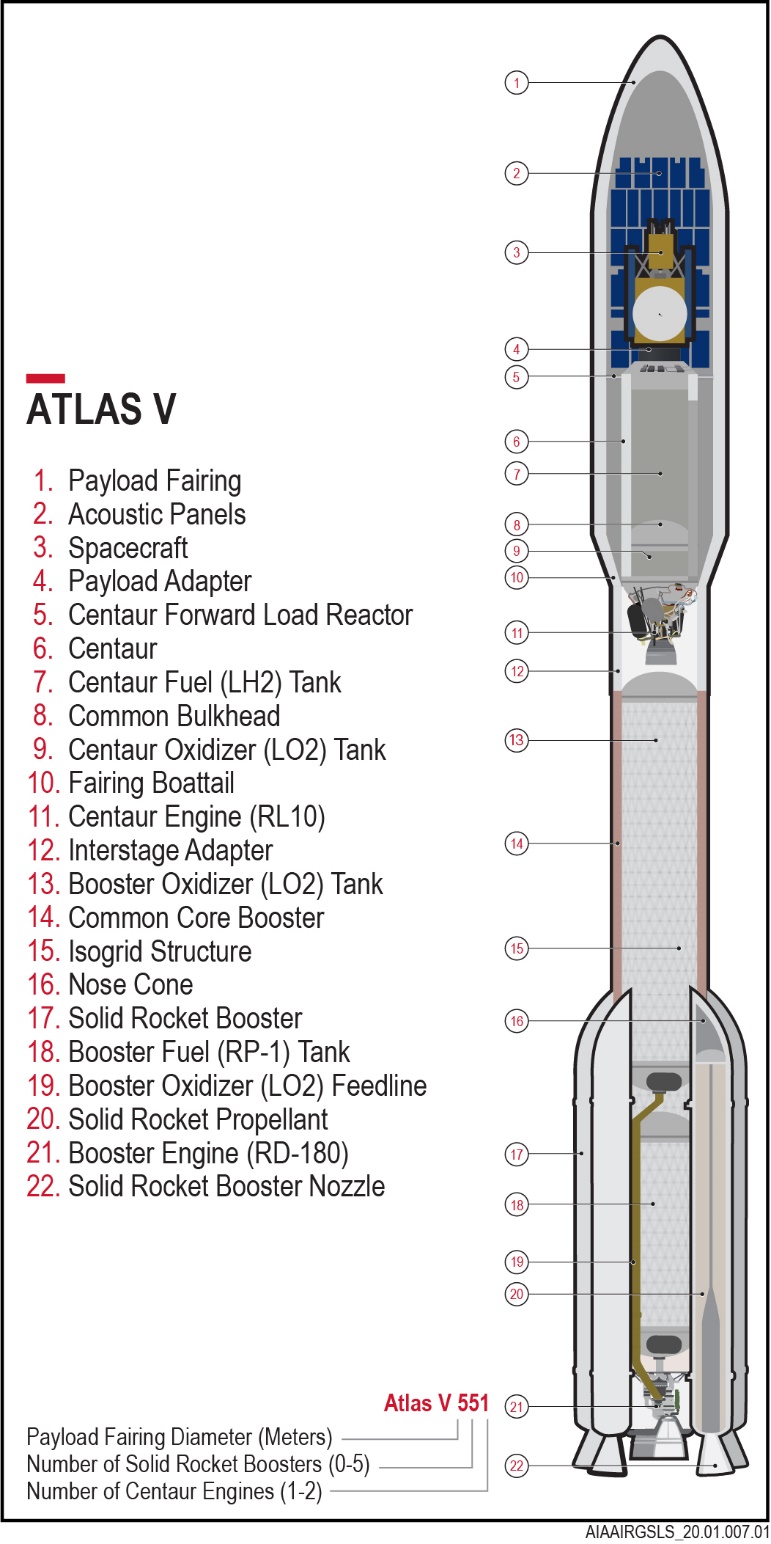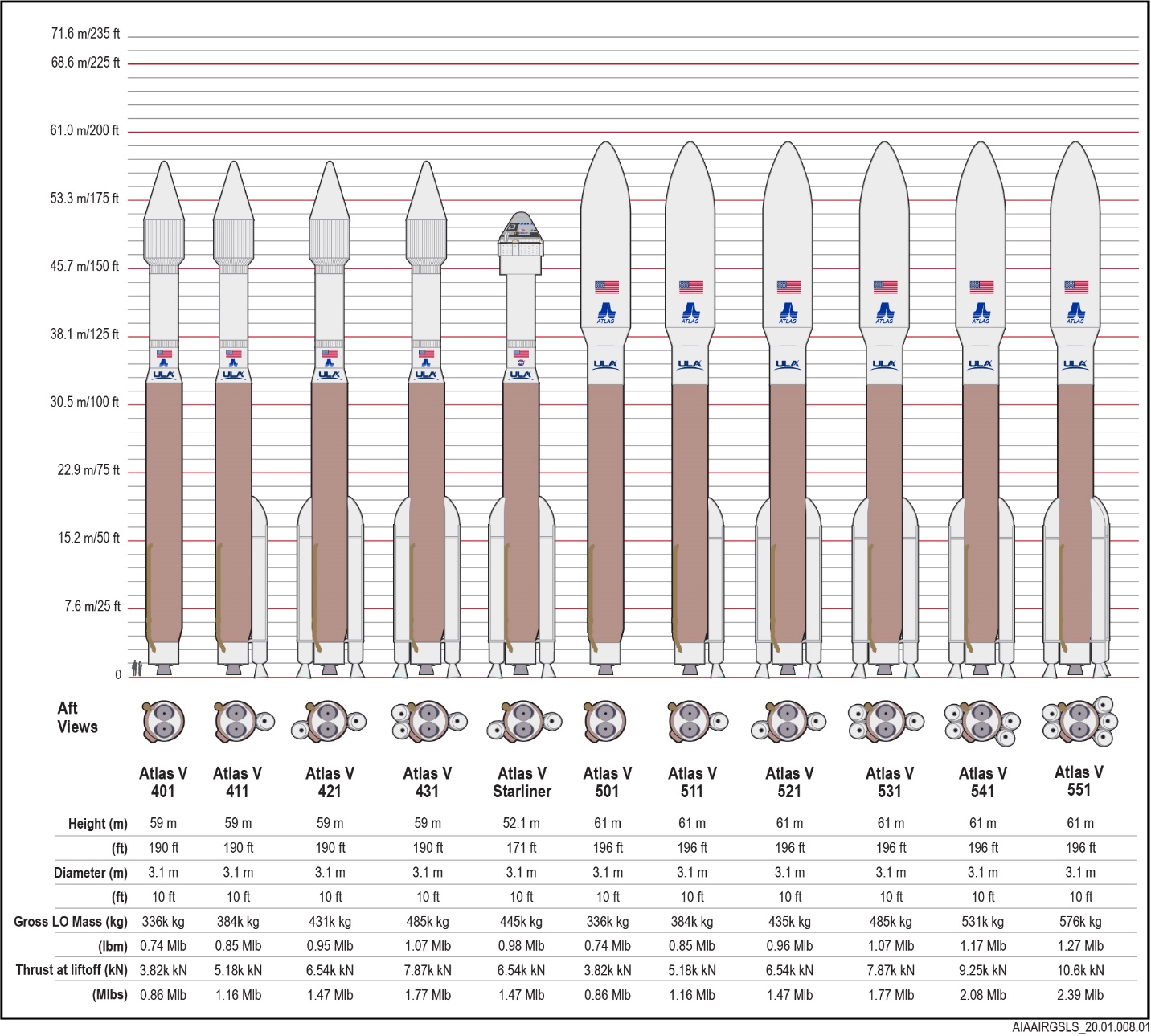Atlas
Vehicle Design

Overall Vehicle Data

Solid Rocket Boosters (SRBs)
Dimensions |
|
|
| Length | 19.5 m (64.0 ft) |
| Diameter | 1.55 m (5.1 ft) |
Mass |
|
|
| Propellant Mass | 42.5 t (93.8 klbm) |
| Inert Mass | 4052 kg (8933 lbm) |
| Gross Mass | 46.6 t (102.7 klbm) |
| Propellant Mass Fraction | 0.92 |
Structure |
|
|
| Type | Filament-wound monocoque |
| Material | Graphite–epoxy |
Propulsion |
|
|
| Motor Designation | Solid Rocket Booster (Aerojet AJ-60), (Northrop Grumman GEM-63 in development) |
| Number of Motors | 0–5 |
| Propellant | HTPB |
| Number of Segments | 1 |
| Average Thrust (per motor) | 1361 kN (305.9 klbf) |
| Isp | Vacuum: 279.3 s |
| Chamber Pressure | 100.9 bar (1463 psi) |
| Nozzle Expansion Ratio | 16:01 |
| Attitude Control |
|
| Pitch, Yaw, Roll | First stage provides control. SRBs have fixed 3-deg nozzle cant. |
Staging |
|
|
| Nominal Burn Time | 88 s |
| Shutdown Process | Burn to depletion |
| Stage Separation | Small thruster firings |
Stage 1: Common Core Booster (CCB)
Dimensions |
|
|
| Length | 32.46 m (106.5 ft) |
| Diameter | 3.8 m (12.5 ft) |
Mass |
|
|
| Propellant Mass | 284.1 t (626.3 klbm) |
| Inert Mass | 20,743 kg (45.7 klbm) |
| Gross Mass | 304.8 t (672.0 klbm) |
| Propellant Mass Fraction | 0.93 |
Structure |
|
|
| Type | Tanks: Structurally stable isogrid |
|
| Aft transition skirt: Integrally machined structure |
| Material | Aluminum |
Propulsion |
|
|
| Engine Designation | RD-180 (Pratt & Whitney/NPO Energomash) |
| Number of Engines | 1 (2 thrust chambers) |
| Propellant | LOX/RP-1 (kerosene) |
| Average Thrust | Sea level: 3827 kN (860.3 klbf) |
|
| Vacuum: 4152 kN (933.4 klbf) |
| Isp | Sea level: 311.3 s |
|
| Vacuum: 337. 8 s |
| Chamber Pressure | 257 bar (3734 psi) |
| Nozzle Expansion Ratio | 36.87:1 |
| Propellant Feed System | Staged-combustion turbopump |
| Mixture Ratio (O/F) | 2.72:1 |
| Throttling Capability | 47–100% |
| Restart Capability | None |
| Tank Pressurization | High-pressure helium |
Attitude Control |
|
|
| Pitch, Yaw | Pumped hydraulic nozzle gimbaling ±8 deg |
| Roll | Pumped hydraulic nozzle gimbaling ±8 deg |
Staging |
|
|
| Nominal Burn Time | 235–250 s |
| Shutdown Process | Burn to depletion |
| Stage Separation | 8 retro-rockets |
Stage 2: Centaur
Dimensions |
|
|
| Length | 12.68 m (41.6 ft) |
| Diameter | 3.05 m (10 ft) |
Mass |
|
|
| Propellant Mass | 20,830 kg (45,920 lbm) |
|
| SEC = Single Engine Centaur, DEC = Dual Engine Centaur |
| Inert Mass | SEC: 1914 kg (4,220 lbm) |
|
| DEC: 2106 kg (4,623 lbm) |
| Gross Mass | SEC: 22,744 kg (50,141 lbm) |
|
| DEC: 22,936 kg (50,565 lbm) |
| Propellant Mass Fraction | SEC: 0.92 |
|
| DEC: 0.91 |
Structure |
|
|
| Type | Tanks: pressure-stabilized monocoque |
|
| Equipment section: skin-stringer |
| Material | Tanks: stainless steel |
|
| Equipment section: Aluminum |
Propulsion |
|
|
| Engine Designation | SEC: RL10C-1 (Aerojet Rocketdyne) |
|
| DEC: RL10A-4-2 (Aerojet Rocketdyne) |
| Number of Engines | 1 or 2 |
| Propellant | LOX/LH2 |
| Average Thrust (Total) | SEC: 101.9 kN (22.9 klbf) |
|
| DEC: 198.4 kN (44.6 klbf) |
| Isp | 450.5 s |
| Chamber Pressure | 32.1 bar (465 psi) |
| Nozzle Expansion Ratio | 85:1 |
| Propellant Feed System | Split-expander turbopump |
| Mixture Ratio (O/F) | 5.5:1 |
| Throttling Capability | None |
| Restart Capability | Multiple |
| Tank Pressurization | Helium gas, autogenous hydrogen |
| Attitude Control | RL10 electromechanical gimbaling |
| Pitch, Yaw | 40-N (9-lbf) hydrazine thrusters |
| Roll | 27-N (6-lbf) hydrazine thrusters |
Staging |
|
|
| Nominal Burn Time | SEC: 900 s |
|
| DEC: 440 s |
| Shutdown Process | Burn to depletion or command shutdown |
| Stage Separation | Payload separation system |
Payload Fairing
